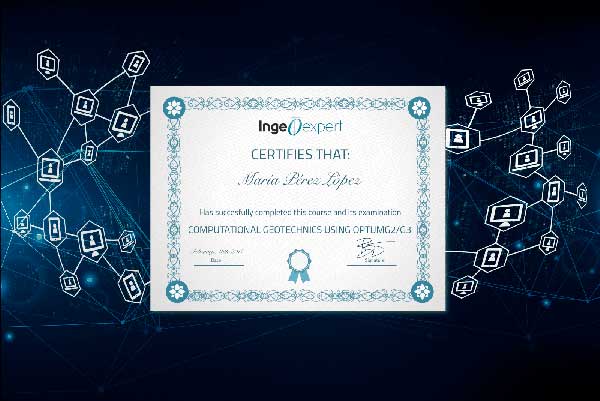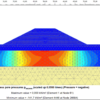Finite element modelling in geotechnical engineering
Online course |
|
50 hours / 6 weeks |
|
|
Dates: 26th of May to 7th of July |
| Standard | Unemployed Or Student |
| $313 | $227 |
Introduction
Finite element modelling is now widely used in geotechnical design and research. Some specialized software packages for geotechnical engineering are available. This course will give an introduction of the basic knowledge for finite element modelling in geotechnics, with focus on practical applications. Instead of teaching you how to use a specific software code, this course aims to teach how finite element modelling works and you will be able to use this knowledge in different software platforms. The finite element software PLAXIS 2D, which is widely adopted for geotechnical design in the world, will be used for exercise in the course.
Objectives
- To understand the basic theories and methods for finite element modelling
- To understand the difference between 2D and 3D analysis for geotechnical engineering
- To learn how to use stress and strain invariants properly in finite element modelling
- To learn how to carry out drained mechanical analysis in geotechnical engineering
- To learn seepage and consolidation (undrained) analysis in geotechnical engineering
- To understand how constitutive models work in finite element modelling and choose proper ones for the analysis
- To understand the limitations and errors in finite element modelling
Week 1: Introduction of finite element modelling in geotechnics
- – Basic principles of finite element modelling
- – Why we use finite element modelling in geotechnical engineering
- – Introduction of finite element modelling software packages for geotechnical engineering
- – Application of finite element modelling in geotechnical engineering
- – Advantages, limitations and errors in finite element modelling
Week 2: Drained mechanical analysis in geotechnical engineering
- – 2D and 3D problems for geotechnical engineering
- – Axisymmetric and plane strain elements
- – Stress and strain invariants
- – Boundary conditions and geometry size for finite element modelling
- – Steps/phases for finite element modelling in geotechnics
- – Practical applications
Week 3: Seepage and consolidation modelling in geotechnical engineering
- – Introduction of the theory for seepage modelling
- – Examples of seepage modelling
- – Introduction of consolidation theory
- – Difference between drained and undrained analysis in geotechnical engineering
- – Examples of consolidation analysis
Week 4: Constitutive models for finite element modelling in geotechnics
- – How constitutive models work and the theory
- – Frequently used constitutive models for soils
- – Advantages and limitations of the existing models
- – How to choose a constitutive model
Week 5: Advanced knowledge of finite element modelling (useful for offshore wind turbine foundation design)
- – Basics of the critical state theory and application in soil mechanics
- – Advanced soil models
- – Application of advanced soil models
- – User defined materials
Dr Gao
- – Dr Gao is a Senior Lecturer in Geotechnical Engineering in the James Watt School of Engineering at the University of Glasgow. He received his PhD degree in Civil Engineering from Hong Kong University of Science and Technology. He has been working at University of Glasgow since 2013. He has received 4 research grants and supervised 4 PhD students. He has been teaching a course on finite element modelling for undergraduate and postgraduate students at University of Glasgow for 8 years.
- – His main research interest is computational geomechanics. He has been working on constitutive modelling of sand accounting for the effect of anisotropy and evolution since 2009. The constitutive model has been used for finite element modelling of practical boundary value problems. This research has shown that anisotropy must be properly considered in calculating the bearing capacity of shallow foundations because an isotropic model can give significant overestimation.
- – Dr Gao has also worked with QTS (https://www.qtsgroup.com/) to develop a design for lightweight rock catch fences through laboratory tests, finite element modelling and full-scale field tests. This project was funded by the Knowledge Transfer Partnership (KTP) of Innovate UK. Based on the outcome of this project, a remote monitoring system was developed with the funding from Construction Scotland Innovation Centre (CSIC). The KTP Associate Dr Hassan Al-Budairi is now working at QTS as a Research and Development Engineer (https://www.linkedin.com/in/hassan-al-budairi-179bbaa4/?originalSubdomain=uk).
- – He is currently working on geotechnical problems associated with climate change and finite element modelling of offshore wind turbine foundations. He has developed a new composite method for constitutive modelling of gassy clay. Papers have been published in Can Geotech J and NAG. He is working with Dr Nabil Sultan on multiphysics modelling of gas migration in clay, with the support of The Royal Society. He is also working with Geowynd (https://geowynd.com/) on finite element modelling of offshore wind turbine foundations in sand. The project is funded by the Royal Academy of Engineering.
The course is delivered online through our easy-to-use Virtual Campus platform. For this course, a variety of content is provided including:
– eLearning materials
– Videos
– Interactive multimedia content
– Live webinar classes
– Texts and technical articles
– Case studies
– Assignments and evaluation exercises
Students can download the materials and work through the course at their own pace. We regularly update this course to ensure the latest news and state-of-the-art developments are covered, and your knowledge of the subject is current.
Live webinars form part of our course delivery. These allow students and tutors to go through the course materials, exchange ideas and knowledge, and solve problems together in a virtual classroom setting. Students can also make use of the platform’s forum, a meeting point to interact with tutors and other students.
The tutoring system is managed by email. Students can email the tutor with any questions about the course and the tutor will be happy to help.
- – Good knowledge in soil mechanics (effective stress principle, consolidation theory, shear strength)
- – Good knowledge in mechanics of materials
- – Experience in using finite element software packages for geotechnics
- – Preferable advanced knowledge in soil mechanics (critical state soil mechanics); Knowledge in finite element modelling theory
Once a student finishes the course and successfully completes the assignments and evaluation tests, they are sent an accreditation certificate. The certificate is issued by Ingeoexpert to verify that the student has passed the course. It is a digital certificate that is unique and tamper-proof – it is protected by Blockchain technology. This means it is possible for anyone to check that it is an authentic, original document.
You will be able to download the certificate in an electronic format from the Virtual Campus platform. The certificate can be forwarded by email, shared on social networks, and embedded on websites. To see an example, click here.
- – Geotechnical engineers for conventional design
- – Geotechnical engineers with special expertise in finite element modelling
- – Geotechnical engineers for offshore wind turbine foundation design
- – Researchers in geotechnical engineering (PhD)
Introduction
Finite element modelling is now widely used in geotechnical design and research. Some specialized software packages for geotechnical engineering are available. This course will give an introduction of the basic knowledge for finite element modelling in geotechnics, with focus on practical applications. Instead of teaching you how to use a specific software code, this course aims to teach how finite element modelling works and you will be able to use this knowledge in different software platforms. The finite element software PLAXIS 2D, which is widely adopted for geotechnical design in the world, will be used for exercise in the course.
Objectives
- To understand the basic theories and methods for finite element modelling
- To understand the difference between 2D and 3D analysis for geotechnical engineering
- To learn how to use stress and strain invariants properly in finite element modelling
- To learn how to carry out drained mechanical analysis in geotechnical engineering
- To learn seepage and consolidation (undrained) analysis in geotechnical engineering
- To understand how constitutive models work in finite element modelling and choose proper ones for the analysis
- To understand the limitations and errors in finite element modelling
Week 1: Introduction of finite element modelling in geotechnics
- – Basic principles of finite element modelling
- – Why we use finite element modelling in geotechnical engineering
- – Introduction of finite element modelling software packages for geotechnical engineering
- – Application of finite element modelling in geotechnical engineering
- – Advantages, limitations and errors in finite element modelling
Week 2: Drained mechanical analysis in geotechnical engineering
- – 2D and 3D problems for geotechnical engineering
- – Axisymmetric and plane strain elements
- – Stress and strain invariants
- – Boundary conditions and geometry size for finite element modelling
- – Steps/phases for finite element modelling in geotechnics
- – Practical applications
Week 3: Seepage and consolidation modelling in geotechnical engineering
- – Introduction of the theory for seepage modelling
- – Examples of seepage modelling
- – Introduction of consolidation theory
- – Difference between drained and undrained analysis in geotechnical engineering
- – Examples of consolidation analysis
Week 4: Constitutive models for finite element modelling in geotechnics
- – How constitutive models work and the theory
- – Frequently used constitutive models for soils
- – Advantages and limitations of the existing models
- – How to choose a constitutive model
Week 5: Advanced knowledge of finite element modelling (useful for offshore wind turbine foundation design)
- – Basics of the critical state theory and application in soil mechanics
- – Advanced soil models
- – Application of advanced soil models
- – User defined materials
Dr Gao
- – Dr Gao is a Senior Lecturer in Geotechnical Engineering in the James Watt School of Engineering at the University of Glasgow. He received his PhD degree in Civil Engineering from Hong Kong University of Science and Technology. He has been working at University of Glasgow since 2013. He has received 4 research grants and supervised 4 PhD students. He has been teaching a course on finite element modelling for undergraduate and postgraduate students at University of Glasgow for 8 years.
- – His main research interest is computational geomechanics. He has been working on constitutive modelling of sand accounting for the effect of anisotropy and evolution since 2009. The constitutive model has been used for finite element modelling of practical boundary value problems. This research has shown that anisotropy must be properly considered in calculating the bearing capacity of shallow foundations because an isotropic model can give significant overestimation.
- – Dr Gao has also worked with QTS (https://www.qtsgroup.com/) to develop a design for lightweight rock catch fences through laboratory tests, finite element modelling and full-scale field tests. This project was funded by the Knowledge Transfer Partnership (KTP) of Innovate UK. Based on the outcome of this project, a remote monitoring system was developed with the funding from Construction Scotland Innovation Centre (CSIC). The KTP Associate Dr Hassan Al-Budairi is now working at QTS as a Research and Development Engineer (https://www.linkedin.com/in/hassan-al-budairi-179bbaa4/?originalSubdomain=uk).
- – He is currently working on geotechnical problems associated with climate change and finite element modelling of offshore wind turbine foundations. He has developed a new composite method for constitutive modelling of gassy clay. Papers have been published in Can Geotech J and NAG. He is working with Dr Nabil Sultan on multiphysics modelling of gas migration in clay, with the support of The Royal Society. He is also working with Geowynd (https://geowynd.com/) on finite element modelling of offshore wind turbine foundations in sand. The project is funded by the Royal Academy of Engineering.
The course is delivered online through our easy-to-use Virtual Campus platform. For this course, a variety of content is provided including:
– eLearning materials
– Videos
– Interactive multimedia content
– Live webinar classes
– Texts and technical articles
– Case studies
– Assignments and evaluation exercises
Students can download the materials and work through the course at their own pace. We regularly update this course to ensure the latest news and state-of-the-art developments are covered, and your knowledge of the subject is current.
Live webinars form part of our course delivery. These allow students and tutors to go through the course materials, exchange ideas and knowledge, and solve problems together in a virtual classroom setting. Students can also make use of the platform’s forum, a meeting point to interact with tutors and other students.
The tutoring system is managed by email. Students can email the tutor with any questions about the course and the tutor will be happy to help.
- – Good knowledge in soil mechanics (effective stress principle, consolidation theory, shear strength)
- – Good knowledge in mechanics of materials
- – Experience in using finite element software packages for geotechnics
- – Preferable advanced knowledge in soil mechanics (critical state soil mechanics); Knowledge in finite element modelling theory
Once a student finishes the course and successfully completes the assignments and evaluation tests, they are sent an accreditation certificate. The certificate is issued by Ingeoexpert to verify that the student has passed the course. It is a digital certificate that is unique and tamper-proof – it is protected by Blockchain technology. This means it is possible for anyone to check that it is an authentic, original document.
You will be able to download the certificate in an electronic format from the Virtual Campus platform. The certificate can be forwarded by email, shared on social networks, and embedded on websites. To see an example, click here.
- – Geotechnical engineers for conventional design
- – Geotechnical engineers with special expertise in finite element modelling
- – Geotechnical engineers for offshore wind turbine foundation design
- – Researchers in geotechnical engineering (PhD)
2 reviews for Finite element modelling in geotechnical engineering
More info
Finish this course and get a certificate based on Blockchain
Finite element modelling in geotechnical engineering

Blockchain technology makes the certificate incorruptible, enabling companies to verifiy its autenticity.
Finite element modelling in geotechnical engineering
| $313 | $227 | |
| Get more information |





Jibran Qadri –
Love the way courses are structured and the modern platform. I am delighted by the way professors teach. Really helpful for the beginners and somewhat to professionals.
Jonathan McDonald –
This course gave me a solid introduction to finite element modelling and the Mohr-Coulomb model, very useful stuff for geotechnical engineers.